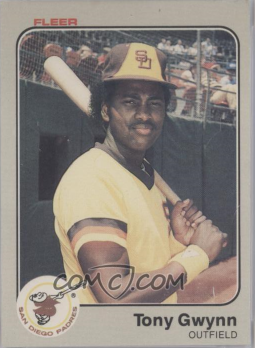 Hall of Famer and Circle of Greats inductee Tony Gwynn passed away today after a lengthy battle with cancer. Gwynn retired in 2001 after a 20-year career, all with the Padres. Gwynn’s 3141 hits are the most in the NL since 1970, and his career .338 batting average is second only to Ted Williams’ .344 among players whose careers began after 1923.
Hall of Famer and Circle of Greats inductee Tony Gwynn passed away today after a lengthy battle with cancer. Gwynn retired in 2001 after a 20-year career, all with the Padres. Gwynn’s 3141 hits are the most in the NL since 1970, and his career .338 batting average is second only to Ted Williams’ .344 among players whose careers began after 1923.
More on the career of Mr. Padre after the jump.
Gwynn debuted in 1982 as a 22 year-old, playing every inning of his first 35 games after a July call-up, and finishing with a .289 average in 209 PA. That would be the last time that Gwynn did not hit .300 in a season. Somewhat surprisingly, Gwynn did not make the big club coming out of spring training in 1983 and struggled after a June call-up, with his season average dropping to .229 after going 1 for 8 in a July 29 double-header. But, Gwynn hit his stride after that, finishing the season with a .339 average over his final 245 PA, including a 25 game hitting streak beginning on Aug 21st. On Sep 14th, near the end of that streak, Gwynn went 3 for 4 against the Giants to raise his career batting average to .300. It would not drop below that level for the rest of his career.
Gwynn’s 19 seasons batting .300 with at least 100 PA trail only Cap Anson and Ty Cobb, with 24 and 23 seasons respectively. Gwynn’s 6 qualifying seasons with a .350 average are tied with Paul Waner, Lou Gehrig and Al Simmons for the most among players whose careers began since the start of the live ball era. With one more game in 1996, Gwynn would have had a 7th qualifying season above .350, exceeded since 1901 only by Cobb, Speaker, Hornsby and Ruth. That batting prowess translated into 8 league batting titles, tied with Honus Wagner for the most in the NL, and trailing only Cobb’s total of 11.
Gwynn was never a power hitter, but did stroke 543 career doubles, including 16 straight seasons above the 20 mark. While Gwynn did not walk a great deal (he had only one season of 60 BBs), he made up for it by striking out even less. A lot less, in fact. Among his contemporaries, Gwynn’s 0.549 career SO/BB ratio trails only Wade Boggs and Ozzie Smith. Gwynn had 13 seasons with as many doubles as strikeouts, more than any other player active since 1966 (and more than twice as many as any player active since 1991). Included were a string of 12 seasons, the longest streak to close out a career since Frankie Frisch‘s 17 straight years ending in 1937.
Gwynn had an unusual “double-peak” career with 30.1 oWAR aged 24-29, then 3 seasons all below 3.0 WAR, followed by a second peak of 20.8 oWAR aged 33-37. Gwynn is the only player in baseball history to bat .350 in 400+ PA in each of his age 34 to age 37 seasons, with all-time rankings of 2nd, 5th, 6th and 2nd respectively for his season averages at those ages.
Probably the biggest what-if of Gwynn’s career is the strike-shortened 1994 season and Gwynn’s pursuit of .400. While Gwynn did not touch .400 after May 15th, he was definitely heating up with the weather that year, riding a .423/.472/.613 second-half slash when the season came to its abrupt and premature end with Gwynn batting .394, the highest qualifying average since Ted Williams‘ .406 in 1941.
Gwynn notched hit number 3000 off Dan Smith of the Expos with a 1st inning single in a wild 1999 game won by the Padres 12-10. The Expos used 5 pitchers that day and Gwynn got a hit off 4 of them. He would have one more 4 hit game that year (part of a 7 for 8 double-header!), the last of 45 for his career.
Gwynn was part of another 3000 hit game two years later. On the last day of Gwynn’s farewell 2001 season, teammate Rickey Henderson led off the home 1st with a double as he and Gwynn became just the 4th set of 3000 hit teammates (the others are Cobb and Eddie Collins in 1927, those two plus Speaker in 1928, and Eddie Murray and Dave Winfield in 1995). Rickey then took a seat to leave center stage to Gwynn, who made a 9th inning pinch-hit appearance with Padres down by 9 runs. It was San Diego’s loudest ever groundout to shortstop.
Quiz time …
I would be remiss in not mentioning Gwynn’s exact contemporary Wade Boggs (Boggs was two years Gwynn’s senior, but both debuted in the same season). The two posted similar career stats in most offensive categories, but the one key area where they differed resulted in an extra 20 oWAR for Boggs, on the strength of almost twice as many walks as Gwynn (and almost twice as many strikeouts, as well) . Curiously, Boggs led his league in IBB for six straight seasons compared to none for Gwynn, but Gwynn had a 203-180 edge in career IBB totals despite about one season’s worth more PA for Boggs. For another quirk, those two and one other player have the only seasons with an unusual batting feat. What is it?
